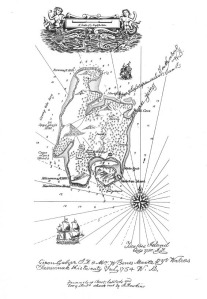Some initial thoughts on Flatland. So, to begin at the beginning with the title page…

Many dimensions
Strange that this has occasioned so little critical comment. Iain Stewart’s excellent annotated edition of the text locates the Shakepearean quotes (Hamlet, Act I Scene v, the appearance of the ghost, and Titus Andronicus, Act III Scene i), both of which are fairly obviously puns and perhaps only tangentially connected to their context. I’m intrigued by the illustration – is it a map? – of a nebulous mass, perhaps fog, perhaps clouds.
It might well be a map. Flatland, ‘a Romance of Many Dimensions’, was published in October 1884. As such it arrived not terribly long into the ‘romantic revival’ of the 1880s, inaugurated, according to most accounts, the previous year, with Robert Louis Stevenson’s Treasure Island. Before that, in the launch issue of Longman’s Magazine in November 1882, Stevenson had given a theoretical outline of his fictional practice with ‘A Gossip on Romance’, advocating a robust, masculine, adventuring, fiction delivering a ‘kaleidoscopic dance of images’ and recalling books read in the ‘bright troubled period of boyhood’. Stevenson’s advocacy of romance has subsequently been read in opposition to Henry James’s championing of the interiorized, feminine and despicably foreign (!) realist novel.
This brief sketch is sufficient for now to give an idea of one aspect of the context into which Flatland arrived: while the descriptive term romance had been used in the title of many earlier nineteenth century novels, and even proto-SF novels – Edward Maitland’s An Historical Romance of the Future (1873) being an (the only?) example of the latter – when Abbott subtitled his book a ‘romance’, he connected it to a very current trend in fiction publishing. There was good reason for so doing: Treasure Island had been a bestseller. The inclusion on the title page of Flatland of a map would have underlined the connection to Treasure Island in particular.

Treasure Island
So is it fog, or is it clouds? The text contains fog – common, apparently, in the temperate regions of Flatland – but the closing illustration repeats the nebulous illustration with more Shakespeare, this time from Prospero’s speech in The Tempest, Act IV, Scene i:
You do look, my son, in a moved sort,
As if you were dismay’d: be cheerful, sir.
Our revels now are ended. These our actors,
As I foretold you, were all spirits, and
Are melted into air, into thin air:
And, like the baseless fabric of this vision,
The cloud-capp’d towers, the gorgeous palaces,
The solemn temples, the great globe itself,
Yea, all which it inherit, shall dissolve,
And, like this insubstantial pageant faded,
Leave not a rack behind. We are such stuff
As dreams are made on; and our little life
Is rounded with a sleep.

The baseless fabric of vision
Thin air, then, and clouds. And I’d suggest that the classical scholar Abbott may also have had in mind an earlier passage of satire, from Aristophanes’ The Birds. In the following exchange the tyrannical Pithetaerus passes judgement on the geometer Meton in his attempt to enter Cloudcuckooland:
(Enter METON, With surveying instruments.)
METON: I have come to you…
PITHETAERUS (interrupting): Yet another pest! What have you come to do? What’s your plan? What’s the purpose of your journey? Why these splendid buskins?
METON: I want to survey the plains of the air for you and to parcel them into lots.
PITHETAERUS: In the name of the gods, who are you?
METON: Who am I? Meton, known throughout Greece and at Colonus.
PITHETAERUS: What are these things?
METON: Tools for measuring the air. In truth, the spaces in the air have precisely the form of a furnace. With this bent ruler I draw a line from top to bottom; from one of its points I describe a circle with the compass. Do you understand?
PITHETAERUS: Not in the least.
METON: With the straight ruler I set to work to inscribe a square within this circle; in its centre will be the market-place, into which all the straight streets will lead, converging to this centre like a star, which, although only orbicular, sends forth its rays in a straight line from all sides.
PITHETAERUS: A regular Thales!
Tools for measuring the air, indeed! This prompts a number of lines of thought. A bone of contention in discussions over higher space concerned its imaginary as opposed to its empirical nature. As an algebraic and then a geometric theory – in other words, as a mathematical construct – higher space remained comfortably ideal. With interventions from physics and Zollner’s catastrophic/catalytic misreading of four-dimensional space, the waters became muddied – or perhaps better to write that the airs became fogged. Was physical space actually four-dimensional?
Higher space existed in the interstices between the ideal and the empirical, as did the emergent sciences of mind, in which perception of space was a primary site of conflict. Abbott’s cloud, then, is thought, imagination, the higher space of mind in which the higher space of geometry existed, an analogue noted by William Spottiswoode in his 1878 address to the BAAS: ‘Or once more, when space already filled with material substances is mentally peopled with immaterial beings, may not the imagination be regarded as having added a new element to the capacity of space, a fourth dimension of which there is no evidence in experimental fact?’
As for Pithetaerus’s remark on Thales, this suggest routing discussions through Michel Serres, whose two essays on the origins of geometry consider the case of Thales and the discovery of mathematical analogy. But I believe that would justify another post entirely and this one already needs more work!


